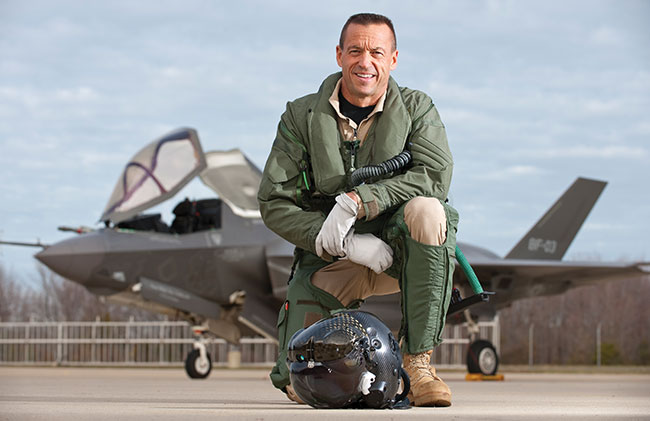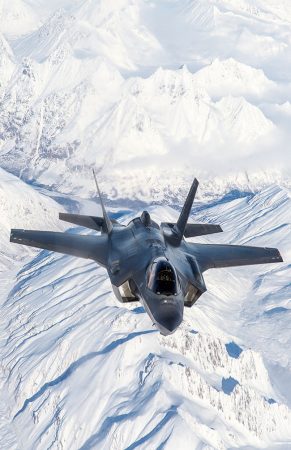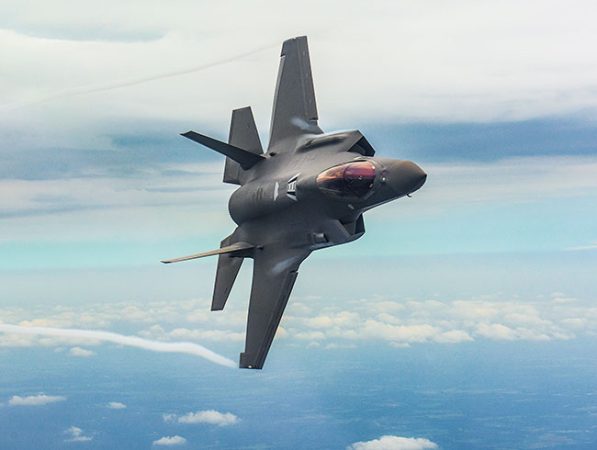
Features
Canada’s Future Fighter
How the Canadian Armed Forces can best integrate the formidable F-35
August 24, 2022 By Jon Robinson
 After 23 years with the Royal Canadian AIr Force, Test Pilot Billie Flynn flew the F-35 for Lochheed Martin for a decade in addition to seven years on the F-16. (Photo: Lockheed Martin)
After 23 years with the Royal Canadian AIr Force, Test Pilot Billie Flynn flew the F-35 for Lochheed Martin for a decade in addition to seven years on the F-16. (Photo: Lockheed Martin)
The Canadian government in March 2022 began the finalization phase of the Future Fighter Capability Program to purchase 88 F-35 Lightning II fighter jets through prime contractor Lockheed Martin and the United States government. The parties will now need months of negotiation on key contractual elements like when and where aircraft are to be delivered, pilot and maintainer training, logistics, and a final price tag – estimated to be worth $19 billion.
Lockheed will appear introspective of its F-35 award until a final stamp of approval, but so ends a decade-plus saga in the competition to replace Canada’s ageing CF-188 Hornet fleet. The F-35 is not just the most significant investment in the Royal Canadian Air Force (RCAF) in more than 30 years, this fighter jet will completely change how the Canadian Armed Forces (CAF) operates for the next four or five decades.
Former Lockheed Martin F-35 Senior Test Pilot Billie Flynn believes Canada must immediately pivot to integrate the F-35 into the CAF. “Fifth-gen marks a revolutionary step for the RCAF and the globalization of this platform, its interoperability, is a key enabler for multi-domain operations,” he explains. Canada’s selection of the F-35 as its Future Fighter actually marks, to the month, 20 years since Flynn elected to move out of flying for the Eurofighter development team and begin a commitment to the F-35 program.
Swiss gov’t warns about possible lag in fighter jet purchase
“I always knew this aircraft had the potential to be a franchise program, much like the F-16 was or the F-4 before that, but I also realized how incredibly difficult it would be to test and develop the F-35,” Flynn says. “The pressure on our test teams, essentially seven days a week, year after year, was unyielding.”
Flynn points to the professionalism of fellow test pilots and engineers from Lockheed whole built the F-35 program as safely and successfully as it was done. This same level of dedication now squarely falls onto the shoulders of the Canadian government to push through hurdles exacerbated by delay. From obtaining the needed “read in” security clearances for a new structure of RCAF leadership to selling the F-35 to the public, Flynn explains Canada might have actually stumbled forward into a perfect time for integrating this “data-gathering spaceship”.
Flynn started flying for Lockheed’s F-35 development program shortly after its third variant, the F-35C, took to the skies in 2010 – preceded by the first flight of the F-35B (STOVL variant) in 2008 and the program’s first flight in 2006 with the F-35 Lightning II AA-1. “I flew the B and C models at 1.6 Mach… at high-end speeds for most of the testing that was done in that regime,” he says, “and it was just so impressive, so fast, in those aircraft – full of bombs and missiles, aggressively maneuvering the airplane and clearing out the envelope.”
When he retired as a Test Pilot from Lockheed in September 2021, Flynn estimates he had roughly the same amount of time in each F-35 variant, even if the C model – beefed up for aircraft carrier operations – was his favourite. “It turns like you’re carving a snowboard in powder at Whistler,” Flynn says. Before flying the F-35, he spent seven years with Lockheed as an F-16 Experimental Test Pilot and, from 1999 to 2003, flew the Eurofighter Typhoon during its prototype program.
Before becoming one of the world’s most revered Test Pilots, Flynn spent 23 years with the RCAF. He was the first Canadian pipeliner pilot to be selected to fly RCAF’s newly acquired fourth-generation CF-18 Hornet, which he would then primarily operate out of Cold Lake, Alberta, and Baden-Soellingen, Germany, as well from Aviano Air Base in Italy during combat. Before retiring from the RCAF in 1999 as Lieutenant Colonel, Flynn commanded the Balkan Rats during Operation Allied Force, flying 25 combat missions in the CF-18 over Kosovo and Serbia.
“For me, flying fighters was all-consuming… up at five o’clock in the morning every workday for 35-plus years. I had this routine to keep myself prepared and safe to fly each day,” Flynn says. He believes he has broken an addiction to speed since retiring from active flying, but he continues to help to train test pilots at the International Test Pilot School in London, Ont., and by working with ICE Leadership as a strategic advisor with subject matter expertise in fifth-generation technology and the F-35’s growing global franchise of air power.

The Lockheed Martin F-35 is a true fifth-generation fighter characterized by its stealth and sensor fusion led lethality. (Photo: Lockheed Martin)
As of April 2022, more than 780 F-35 aircraft had been delivered, accounting for more than 500,000 flight hours. This fleet also includes more than 1,630 F-35 Lightning II pilots and 11,890 maintainers of the aircraft. Among the 14 Air Force services flying the F-35, accounting for more than 291,000 sorties, seven countries have used the F-35 in operational missions, with nine countries total operating the aircraft on home soil. The F-35 has now been activated at 25 of 43 bases and on nine of 19 ships, for a total of 34 current activations.
“This is a brilliant win for the RCAF and it averted what would have been disastrous for Canadian industry if the government had abandoned the F-35 program,” Flynn says. A July 2021 article by Lee Berthiaume of Canadian Press notes Canada quietly made another annual payment to remain a partner of the F-35 Joint Production Office, which it joined in 1997, bringing its total investment in the fighter’s development to $786 million. Berthiaume also notes Canadian companies have secured more than $2.5 billion in production and maintenance contracts related to the stealth fighter over that time. More than 100 Canadian companies contribute to the F-35 production chain and this value will only expand under Industrial Technological Benefits obligations of the Future Fighter award.
“The F-35 sparing mindset is completely different than what we did with older airplanes, when we just bought tires and engines, stockpiling enough spare parts to keep our fleets in the air,” Flynn explains. “The mindset for F-35 is a lot like UPS, FedEx and DHL where we share a logistics network amongst partner nations.”
Flynn believes Canada needs to immediately stop all work and funding for the second phase of the Hornet Extension Program, HEP 2. He notes there is nothing in the capability of HEP 2 upgrade path that helps lead the CAF to the fifth-generation F-35, pointing to historical examples of unrealized CF-5 and T-33 upgrades.
In terms of F-35 maintenance, as of April, there are now 38 of 68 component repair activations that are currently planned out to 2027. In terms of man hours per flight hour, the F-35A has decreased from an expected requirement of nine hours to 5.8 hours. Since 2015, the cost per flight hour, as it relates to Lockheed’s owned portion of the F-35, has been reduced by 45 per cent. The price of the aircraft itself has dropped from well over $125 million to below $80 million. “There is an advantage to being late to this F-35 game, and that is that we can lean on the lessons learned by our USAF and NATO partners,” Flynn says. “At Luke Air Force Base, there is a mature F-35 training program that will teach pilots not just how to fly this aircraft but how to master the new mission sets.” This includes new roles the F-35 is capable of that Canadians cannot fly now. “It will teach Canadians about how to manage the cyber capabilities and extremely high security levels of the F-35.”
Flynn highlights the need for the CAF to immediately transform its approach to cyber warfare when integrating the F-35, particularly with ground installations that support the aircraft. Work on constructing the installations has started in CFB Cold Lake and CFB Bagotville (even before the F-35 was selected) for the CAF to essentially manage what Flynn labels as a spy plane. “Every part of F-35 operates at a level of cyber protection of security which is an order of magnitude more complex than the Canadian military has ever had to deal with,” he says. Security clearances will impact everyone from pilots to building custodians.
“You have to – at all costs – protect the aircraft from the cyber threats. China and Russia are decades behind the F-35 and this technology overall. Their only way to catch up is to steal it from us,” Flynn explains. “You can be certain that the U.S. government will ensure that the installations in Canada and the management of everything related to F-35 is done as demanded.”
Flynn continues to explain other countries can copy the look of a stealth fighter, but there is no way for them to match the capabilities of the F-35 or F-22, largely based on 40-plus years of Lockheed developing stealth aircraft, tracing back to the F-117 Nighthawk (first flight 1981). The F-35 takes stealth a step further still and marries it with sensor fusion. Flynn explains: “The sense of impunity and omnipotence that comes with flying an F-35 in a combat type environment, where you know that you see everything, and you know that they don’t see you, it is like playing football when one team is invisible, and the other team isn’t. You learn quickly that it is not a fair fight and you don’t ever want it to be fair again.”
Flynn describes how war is changing by pointing to Russia’s invasion of Ukraine and the high-end fight, with Canada maybe now seeing why we have to arm our military for the Russian or even Chinese threats. “Canadians now appreciate what we have been told for years but ignored, that Russia is a real threat in the Arctic. They have re-energized, rejuvenated their Arctic bases. They can launch bombers from Russian territory and fire into North America with impunity right now. And Canadians realize that we need a NORAD capability to protect continental North America.”
Flynn explains this is another example of how Canada might have stumbled forward with its late F-35 selection, allowing the country to lean on the U.S.-led NORAD concept of operations because they are so far ahead. There are now 14 Air Force services deploying the F-35 to learn from, including the likes of Northern climate countries like Norway and Finland, which recently selected the F-35. There are 54 F-35A aircraft now based at Eielson AFB in Fairbanks, Alaska, which will be key to aiding the RCAF on operations in the Arctic. Canada will focus its stealth fighter investment on the F-35A variant with a drag chute option to operate on shorter and icy runways.

Test Pilot Billie Flynn flew the F 35 for Lockheed Martin for more than a decade.
“The F-35 is the most survivable, most effective and most lethal fighter that flies in the world today. It has become the world standard for fighter aviation and how it will change in the decades to come pushing advanced technologies,” Flynn says. “In the case of Canada, the F-35 will help us protect our coastlines and the Arctic, to be an integral part of the global network of fifth-generation fighters and, most importantly, to keep our men and women who fly it safe every single time. It has 40 years or more of life ahead of it.”
While legacy aircraft like the F-18 were used to shoot down cruise missiles, Flynn explains F-35 pilots will be trained to shoot down bombers before they can ever fire against Canadian interests. “We will not be training to shoot down the arrows, we will be shooting to kill the archers. That is what our future is.” Flynn notes this future will also incorporate armed unmanned vehicles with an F-35, will communicate with both ground and space assets, and will enable true multi-domain operations. “We will fire weapons that do not just go supersonic, but rather six times the speed of sound – hypersonic weapons. We will adapt to those in the F-35. War as we know it will change dramatically in the four to five decades to come of the F-35’s life and it will grow and adapt with the combat needs.”
Flynn estimates there are only 50 combat-ready CF-18 fighter pilots in the RCAF of the 150 pilots needed for the program. “F-35 pilots – fifth-generation pilots – are clearly a different generation than the one I grew up in,” Flynn says. “They consume and process information differently. They have an appetite for the level of knowledge that is given to them in a cockpit of an F-35… All they will know is 8.6 million lines of software code presenting everything in the world that happen 360 degrees around them on their cockpit screens and helmet-mounted displays as they fly.
“The situational awareness they possess is light years more sophisticated than any of us fourth-gen pilots can imagine,” continues Flynn. “Flying the aircraft isn’t the secret of F-35. Mastering the global situational awareness, controlling the battlespace, surviving in the highest threat environments in the world, and being as lethal as the F-35 can be, that is the secret.”
As for earlier criticisms that the F-35 is not a dogfighting aircraft, it was Flynn who put much of that discussion to rest by orchestrating the first F-35 demonstration at the Paris Air Show in June of 2017. “We ended the conversation forever about how maneuverable an F 35 was and whether it could dogfight or not. We created a maneuver called the Pedal Turn where we spiral down in front of the crowd at 50 degrees angle of attack, yawing at 50 degrees per second like a helicopter, which is essentially slower than even an F-18 can fly,” Flynn says.
The power of air shows cannot be understated, particularly when it comes to selling the Canadian public on the F-35 program, which is a story best told by RCAF fighter pilots. “It’s going to be hugely exciting for people to now go to Toronto on Labour Day weekend and see the F-35 perform, or at Abbotsford or London air shows, because it’s ours now.”